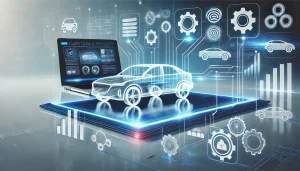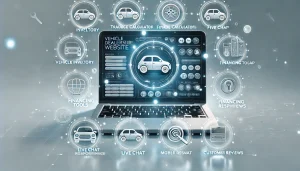The Essential Five: Must-Have Strategies for Every Successful Car Dealership in 2025

In the ever-evolving automotive market of 2025, success can’t be achieved without deep insight into how to use digital tools and strategies for winning and retaining customers. The traditional process of buying a car, once characterized by visits to the dealership, has been transformed with the rise of digital platforms. Creating compelling online experiences for today’s dealer will be what attracts prospective customers and moves them along through the process-so critical as one wants high satisfaction with each customer interaction.
A dealership website has evolved from just a simple, one-dimensional ‘brochure site’ to a multilevel and dynamic tool for being the spine of the overall sales process for every dealership. Moving forward, our next five must-do strategies that will guarantee every car dealership a competitive position in 2025 to attract the today’s techno-savvy buyer with ease.
1. Dynamic and Easy-to-Use Car Dealership Website
Basically, an effective and engaging online presence for your dealership starts with a website that offers seamless, intuitive user experiences. The website should be an extension of the dealership itself, availing the customer with all they would have been exposed to at the dealership for informed decision-making from the comfort of their homes. This cannot just be some static website anymore. Instead, dealers must develop dynamic, functional, and aesthetically appealing platforms.
Full Vehicle Listings
Each vehicle listing should be built for a comprehensive and easy-to-navigate overview of the vehicle. Today’s consumer wants to have all the detailed specifications, high-resolution images, and in some cases, videos showing the vehicle in action. The listings shouldn’t only give the make, model, and year; the information should further extend to specific details, including fuel efficiency, safety ratings, trim levels available, and color. Most buyers nowadays are visual, so photos from every possible angle in multiple environments are always a plus. It could also be 360-degree images and videos enabling customers to virtually explore the car. The improved shopping experience would encompass enhanced search functionality.
With a dealership having a wide range of cars, there is a need to introduce appropriate search filters for the user to narrow down his choices with regard to certain preferences. The filters should include features such as price range, vehicle type-SUV, sedan, truck, color, mileage, year, among others. This will keep your probable buyers engaged and save them from spending time browsing through items that do not interest them.
Car Dealership website Mobile Optimization
Car dealers really have to have a website optimized for mobile, since an increasingly large number of customers browse the web through smartphones and tablets. This means that on a mobile-optimized site, potential customers will be able to navigate, browse, and even make inquiries about vehicles with ease, no matter what device is used. Be it comparing cars on the go or booking a test drive from the comfort of the living room, having a responsive and well-designed mobile site will ensure that the user experience is smooth. This convenience can greatly enhance customer satisfaction and raise conversion rates, which makes mobile optimization an indispensable feature for any successful car dealership website.
Fast Loading Times and Technical Reliability
Besides being mobile-friendly, speed and technical reliability make a car dealer’s website perform well. Given the fact that users will never wait to browse a site when it takes more than three seconds to load a page, all car dealers should really do to be at speed for users is optimize all their pages. A fast, frictionless user experience not only keeps your prospects engaged longer but also diminishes bouncers while their intent for a conversion goes upward.
Second important would be a technically sound site. A rock-solid infrastructure guarantees that your site is online, enabling prospects to view information about their future purchases or book test drives without glitches or downtime. Inconsistent performance will frustrate them and make them lose trust in your dealership, affecting user experience and sales negatively. By focusing both on speed and technical reliability, car dealerships are able to create a website that fosters trust, keeps users engaged, and supports a successful sales process.
2. Integrated Online Financing and Payment Options
Perhaps one of the most daunting tasks for anyone who has ever bought a car is trying to make sense of and navigate the financing options available to them. The most successful dealers in 2025 integrate online financing tools into the ease of the entire buying process. By offering online financing options directly on your website, you’re creating convenience for your buyer and increasing the chances of closing the deal.
Pre-approval and loan calculators for Car Dealership
One of the major modern features to be integrated into the car dealership website involves calculators for financing. These calculators will allow customers to estimate their month-to-month payments depending on loan term, interest rates, and down payments. Most of today’s buyers would want to know how much they are going to pay monthly before they enter any dealership; loan calculators make this process quite easier for them. Online pre-approvals will help buyers to understand how much they can afford and what they can borrow without having to visit a dealership.
Flexible Payment Plans for car dealership
With the rise in online purchases of goods and services, buyers look for flexibility even in making payments. Car dealerships have to establish different modes of payment, including deferred payment, lease-to-buy options, and subscription-based services, to meet the changing expectations of customers. Such flexible plans need to be uncomplicated and friendly according to the buyer’s preference. It will be a plus if online touchpoints enable them to compare all the financing options available and choose an offer that best fits their needs.
Seamless Integration with Lenders
Car dealers should integrate their online financing options smoothly, including multiple lender options, crystal-clear and transparent conditions, and the possibility to finalize the whole procedure online from application to approval. In such a case, by paving the way of financing smoothly, it will be easier for dealership businesses to gain consumer trust and give a far better customer experience overall.
3. Immersive Virtual Test Drives and Interactive Tools for Car Dealership
While nothing replaces the hands-on sensation of driving a car, technology has advanced to such a degree that virtual test drives can be almost as immersive and instructive. In 2025, car dealerships that integrate immersive virtual experiences will be better positioned to engage customers and reinforce their online presence.
Car Dealership Virtual Test Drives
Virtual test drives have turned out to be one of the most interesting ways to allow buyers to experience car performance without necessarily leaving their living rooms. These test drives often feature video content that simulates driving the car, taking customers on a virtual ride across various terrains and conditions. Some go as far as using augmented reality and virtual reality to provide users with interactive experiences that enable them to virtually “sit” inside the car, look at the dashboard, and have a feel for the features of the car.
360-Degree Interactive Walkarounds
Dealerships can do this one better with 360-degree interactive images whereby customers can go through every aspect of the car virtually. This level of immersion allows customers to explore interior and exterior details inside the car, and even down to trunk space and the engine compartment, just as they would inside the physical dealership. This kind of interactive tool is all about customer comfort and transparency, and such small bits can go a long way in building trust and confidence.
Configurators of Car Dealership
Other than that, another critical feature in a modern car sales website should be the customer’s ability to personalize their car of choice. Customization tools let users select specific colors, trims, and optional features and see how the final vehicle will appear in real time. This not only enhances customer satisfaction but also opens avenues for dealerships to upsell options at higher margins.
4.Personalized Customer Support for Car Dealership with Real-Time Communication

In today’s digitized environment, personalization in customer support acts as the anchor for building lifelong relationships with customers. Beyond ‘hello’ and ‘welcome’, dealerships should progress to providing more personalized responses in real-time, customized for each client. It can be provided via different channels: interactive live chat for real-time communication, informative video consultations that allow establishing a personal contact, or a separate customer support team ready to answer all questions and guide prospective buyers through the decision-making process. This way, with personalized responsive support, a dealership is able to nurture trust and loyalty in their clientele.
Live Chat and AI Chatbots in Car Dealership website
Live chat on your dealership website is a must-have tool used to further engage visitors right in the now. By offering live chats, a dealership could provide instant support, answer questions regarding specific vehicles, and even help site visitors navigate the website. Integration of AI-powered chatbots can be a plus in furthering this experience by providing immediate responses to common inquiries when live agents are not available. These tools should be able to offer every customer personalized responses related to browsing behavior and the history of interactions made, allowing for a more engaging and relevant experience for customers.
Video Consultations and Virtual Showrooms for Car Dealership
Video consultations will surely gain further prominence, what with increasing expectations from consumers about personalization. Virtual consultations in today’s age are the ways one could let a probable customer ask queries, view a vehicle in detail, and get guidance from sales people via video conferencing platforms. Virtual Showroom Experience In dealerships with large inventory, this will allow customers to walk through a dealership and look at the vehicles live with the support of a knowledgeable sales representative.
Follow-Up and Retargeting
Once a visitor has started interacting with your dealership website, it is necessary to follow up with them and keep the relationship warm. Automated email follow-ups, recommendations based on their browsing behavior, and retargeting ads either on social media or other websites would help ensure that, at all junctures in their journey, the customer stays engaged and thus converts more surely.
5. Data-Driven Insights for Continuous Improvement for Car Dealership

In 2025, data has become an indispensable part of optimizing car dealership websites. As the automotive industry increasingly shifts into the digital space, leveraging data to enhance online customer experiences has become a fundamental strategy for every car dealership desiring success. Capturing and analyzing key metrics, including website traffic, user behavior, conversion rates, and engagement patterns, empowers car dealerships to make informed, strategic decisions that directly impact online performance and sales outcomes.
Data provides critical insight into the behaviors and interactions that your prospects are making with your websites. Tracking metrics-page visits, time of stay on a particular page, click-through rate, and bounce rates-provides more insight to see what exactly does and doesn’t work on a site for car dealerships. For example, if a certain vehicle listing is receiving lots of interest but users aren’t moving to book a test drive or send in questions, the car dealership can concentrate its efforts on enhancing calls to action or giving more detail about the next steps involved in the buying process.
The foundation of every successful car dealership is to understand user behavior. It allows the dealer to analyze the data for the most in-demand vehicles, features, or financing options and create more focused content on the website to attract that audience. This helps the business understand how customers interact with virtual interactive tools, such as virtual test drives, 360-degree images of the interior, or a loan calculator. That will allow a car dealership to optimize its user journey and focus on customer-centric enhancements.
Another very important aspect where data analysis can come in very handy is in conversion rates. By tracking the number of website visitors completing desired on-site actions, such as submitting a contact form, scheduling a test drive, or starting a purchase, car dealerships can be able to tell how well their website is driving sales. Low conversion rates often indicate points of friction in the buying process, including poor site navigation, unclear pricing, or complicated financing options. By pinpointing these issues, a car dealership can make certain changes that help in enhancing customer experiences for higher conversions.
Data also grants car dealerships a competitive advantage in marketing. With precise knowledge of who visits their sites, it enables dealerships to segment their audiences based on location, browsing behaviors, and demographics. In this way, targeted and personalized marketing campaigns can be created to make sure the right messages are received by the right customers at the right time. Whether it be promoting new vehicle releases, offering special financing deals, or sending service reminders, data-driven strategies make car dealerships more effective at marketing.
With time, it enables car dealerships to paint accurate pictures of their customers through continued data collection and analysis, refine the content of websites, and strategies to meet ever-changing market demands. Such an iterative process ensures the dealerships will be agile and responsive, fully optimizing their website and sales processes to capture leads, foster relationships, and ultimately convert visitors into loyal customers.
In today’s competitive digital marketplace, car dealerships can no longer afford to ignore data. The ones that move toward a data-driven approach are more capable of satisfying the needs of consumers, enhancing their online presence, and maximizing their sales potential. By using data effectively, car dealerships can stay ahead in the rapidly evolving automotive market and ensure long-term success and growth.
Customer Analytics for Car Dealership

It’s all about understanding customer preference to offer a personalized experience. By using analytics tools to track which vehicles are getting the most attention, which pages have the highest bounce rates, and where customers are falling off in the buying process, dealerships can quickly identify areas for improvement and optimize their websites accordingly. The use of personalized content, based on browsing history or past purchases, can further drive engagement and conversion.
A/B Testing for Car Dealership
The A/B testing should be quite frequent in order for dealers to tweak those website elements that may help improve results. Test different layouts, calls to action, and promotional banners. One gets a view on what appeals and what doesn’t to customers. With the ability to constantly fine-tune their site from their findings, they would have better experiences, translating to better sales for the dealers.
CRM Integration for Car Dealership
Integrating a CRM system into your dealership website can greatly enhance both the customer experience and internal operations. A properly implemented CRM system does not just store basic contact information but tracks every interaction with your potential and existing customers, providing a complete view of the customer’s journey. This invaluable data will help dealerships understand customer preferences, purchasing behavior, and buying patterns that can be used to offer a more personalized and relevant experience.
To the sales teams, this will translate into their better preparedness to follow up with leads in a timely and knowledgeable manner. This replaces generic outreach by utilizing the insight provided through the CRM system in order to tailor their communication to the specific interests of the potential customer, previous interactions, and even the potential concerns that may be inhibiting a purchase. This not only increases the likelihood of conversion but also builds long-term relationships with buyers.
Moreover, CRM data can also enable a dealership to segment its audience into buying stage, vehicle preferences, and even financial qualifications, among other factors, for the crafting of very targeted marketing campaigns. This makes sure that the right message is given to the right people at the right time. Whether it’s special promotions, service appointment reminders, or notification of new inventory, CRM systems can empower the dealership to interact better with customers and enhance sales, thereby increasing customer satisfaction overall.
Conclusion
The automotive landscape is swiftly shifting to a complete digital experience in 2025. Only the car dealers who can harness such power with an interactive, easy-to-use website, online financing, virtual test drives, personalized customer care, and data-driven insight will be well-placed to make the most of this competitive market. By paying attention to creating a smooth, engaging, and transparent online shopping experience, the dealerships will be able to gain the customer’s trust, improve sales, and nurture long-term relationships. Finally, car dealerships will succeed in a digital-first world with the adaptation of these key strategies.
For additional information, click here.